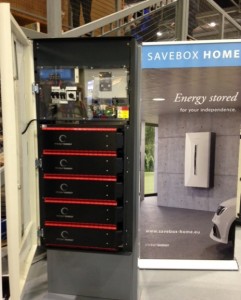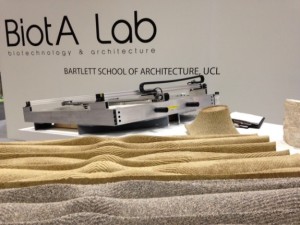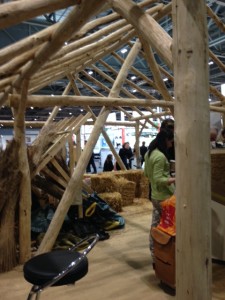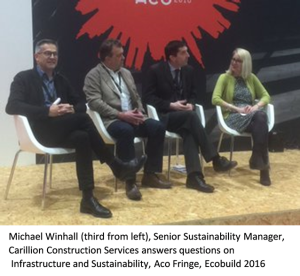Erica Russell, Doctoral Practitioner, University of Surrey/Carillion plc
The first impression as you moved through the show was a constant booming of microphoned voices. From the Conference arena to the new multiple learning hubs, the fringe, the resource theatre to stands with their own mini conference seating there was an endless stream of information. Clients, designers, estate agents, contractors, government agencies and smaller companies all joining together to provide insight on nearly every aspect of sustainability and the built environment. And people seemed hungry to learn – on one stand a small space was filled with chairs; 8 men leaned forward attentively listening to a technical product discussion illustrated by slides so informatively detailed they were unreadable – they were not deterred. For most of the conference presentations seats were full and many stood for an hour to listen.
Over 40,000 industry professionals visit Ecobuild each year and even though the show was smaller than a couple of years ago, partly due to a reduced contingent of Asian solar panel and component manufacturers, solar was still well represented, along with digital controls, biomass and air source heat pumps. It was also interesting, alongside this to see a greater number of battery storage options being exhibited and to support this area a very useful publication launched by the REA in January on the current state of both grid scale and home use in the UK. An increasing number of products offered information on embodied carbon and there seemed to be a stronger emphasis on the ‘whole life’ of product impacts. One good example of this was The Concrete Centre’s latest report ‘Whole-Life Carbon and Buildings’. However, a particularly impressive expression of ‘whole life thinking’ was a talk by Armstrong’s, in the Resource theatre. Here they gave insight into their own journey into the circular economy. The company are manufacturers of ceiling tiles who were interested in the concept of circularity but like many companies struggled to understand how to apply it. They set themselves a challenge to test their thinking and they felt that only by ‘getting on with it’ have they really started to understand the opportunities. They see it much more a challenge of eco-effectiveness rather than eco-efficiency! Armstrong’s offer a take-back service for all ceiling tiles and offcuts, seeing it as a resource rather than a liability. They operate across the world and are now certified to the Cradle to Cradle standard. It’s a relatively new accreditation but is now being used by Google as part of their building developments, has been adopted by BREEAM in the Netherlands and features in the Swedish and German national materials databases.

Photo: Erica Russell (CC-BY-NC)
It was also encouraging to see that the show continues to demonstrate both traditional biobased building materials and skills, as well as an increasing and interesting melding of bio and high tech, such as the natural form inspired 3D printed concrete materials from BiotA Lab at UCL.

Photo: Erica Russell (CC-BY-NC)
Most intriguingly of all – the ‘grown brick’ from BioMason. This award winning start up company’s product was exhibited by industry wholesaler, Travis Perkins as part of their ‘Future Innovation’ thinking. The young American company has been working since 2012 to develop a process to ‘grow’ bricks from sand, bacteria and water. Now able to create the product they are completing their pilot phase and will shortly be looking to licence the process for the product to be made on site. And with traditional brick making currently producing 800 million tonnes/annum of CO2 worldwide a brick that requires no firing, and appears to be 2-3 days quicker to produce, is worth watching. The big innovation challenge, sponsored by M&S, offering similar support to the winner as the RBS programme was won by Waterblade, a small company offering a new style of tap that reduces water use by 50%.

Photo: Erica Russell (CC-BY-NC)
It was also enlightening to see that whilst often dwarfed by the large stands of manufacturers’ representatives from wildlife organisations were also busy! Carbon and climate change have been focusing many thoughts but biodiversity also sets the construction industry a major challenge and increasingly this is being presented by major clients as a vision of ‘net positive’. Whilst there is frustration at times that the built environment, with its massive impact on global materials and emissions is not moving fast enough to change, it is clear that collaboration and ideas are thriving. Ecobuild certainly gave visitors the opportunity to see, learn and debate the very wide range of continuing issues that are being given greater profile within major public contracts, legislation and standards.

